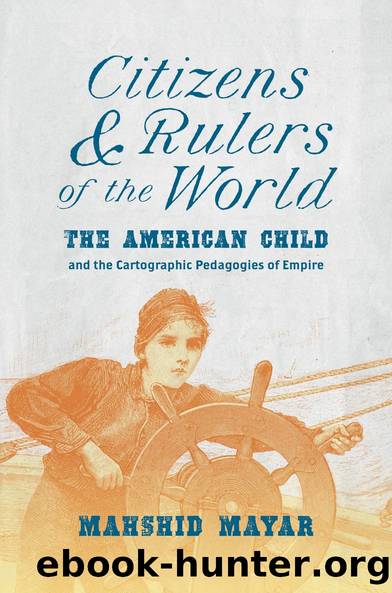Citizens and Rulers of the World by Mahshid Mayar

Author:Mahshid Mayar [Mayar, Mahshid]
Language: eng
Format: epub
Tags: Social Science, Ethnic Studies, American, General, History, United States, 19th Century, Political Science, Geopolitics, Historical Geography
ISBN: 9781469667294
Google: bb1FEAAAQBAJ
Publisher: UNC Press Books
Published: 2022-03-29T02:50:58+00:00
Childrenâs Magazines as Accidental Archives: Editors and the Writing Child
Justifying the necessity of launching a juvenile monthly with Scribner and Company, Mary Mapes Dodge spelled out her views regarding childhood and the reading child in âChildrenâs Magazines,â anonymously published in Scribnerâs Monthly in July 1873. Warning that European, especially British and German, juvenile periodicals âdistract [childrenâs] sensitive little souls with grotesquerie,â Dodge then turned to American childrenâs periodicals: âWe edit for the approval of fathers and mothers, and endeavor to make the childâs monthly a milk-and-water variety of the adultâs periodical. But, in fact, the childâs magazine needs to be stronger, truer, bolder, more uncompromising than the other. Its cheer must be the cheer of the birdsong, not of condescending editorial babble.⦠A childâs magazine is its pleasure-ground.â3
Childrenâs letters belonged to a pen-and-paper corner of this âpleasure ground.â Informed by these views, epistolary spaces of interaction between young letter writers, adult editors, and their young readers constituted a constant feature of both St. Nicholas and Harperâs Young People from their very first issues.4 Unlike the more private letters that both adults and children commonly exchanged with each other, âfan lettersâ by children were in fact part of a larger public epistolary tradition with the power to satisfy, at least partially, the emerging American middle classâs desire to enter public conversations that had for long been going on exclusively among the elite.5
Since St. Nicholas was first published in 1873, letters by readers had been one of the magazineâs columns. This had allowed Mary Mapes Dodge, St. Nicholasâs editor during its first three decades of publication, to develop strict yet receptive editorial policies regarding which letters were printed. Harperâs Young People, too, launched its Our Post Office Box column in its first issue with a call for letters.6 Following the initial call, the column started with two very short letters in the second week of its publicationâthat is, Tuesday, November 11, 1879: Willie J. H. wrote a letter in which he asked a question about his pet alligator, while Lulu W. inquired after the possibility of establishing a âwork-box department for little girlsâ at the magazine. Over the years, with the ultimate power to decide which letters were printed and to what degree they should be edited beforehand, adults would set the standard for âprintableâ letters. Put differently, the prototype for the childrenâs public letters under study here was built around the examples provided and the expectations set by the letters that had already found their way to The Letter-Box and Our Post Office Box by editorial decision.
As more letters were received, the âPostmistressâ started the first Our Post Office Box in 1880 to suggest topics about which its young readers could compose letters: their pets and their observations of nature, including birds and flowers.7 A decade later, American children were writing letters about numerous other subjects, ranging from the color of their eyes and hair to their views on the Spanish-American War, and from what they thought of non-Americans to their encounters with migrants in New York.
Download
This site does not store any files on its server. We only index and link to content provided by other sites. Please contact the content providers to delete copyright contents if any and email us, we'll remove relevant links or contents immediately.
| Historic | Information Systems |
| Regional |
Man-made Catastrophes and Risk Information Concealment by Dmitry Chernov & Didier Sornette(5921)
The Revenge of Geography: What the Map Tells Us About Coming Conflicts and the Battle Against Fate by Kaplan Robert D(4035)
Zero Waste Home by Bea Johnson(3777)
COSMOS by Carl Sagan(3554)
Good by S. Walden(3485)
In a Sunburned Country by Bill Bryson(3481)
The Fate of Rome: Climate, Disease, and the End of an Empire (The Princeton History of the Ancient World) by Kyle Harper(3003)
A Wilder Time by William E. Glassley(2818)
Camino Island by John Grisham(2762)
The Ogre by Doug Scott(2631)
Organic Mushroom Farming and Mycoremediation by Tradd Cotter(2626)
Human Dynamics Research in Smart and Connected Communities by Shih-Lung Shaw & Daniel Sui(2465)
Energy Myths and Realities by Vaclav Smil(2438)
The Traveler's Gift by Andy Andrews(2409)
9781803241661-PYTHON FOR ARCGIS PRO by Unknown(2321)
Inside the Middle East by Avi Melamed(2305)
Birds of New Guinea by Pratt Thane K.; Beehler Bruce M.; Anderton John C(2224)
A History of Warfare by John Keegan(2185)
Ultimate Navigation Manual by Lyle Brotherton(2129)
